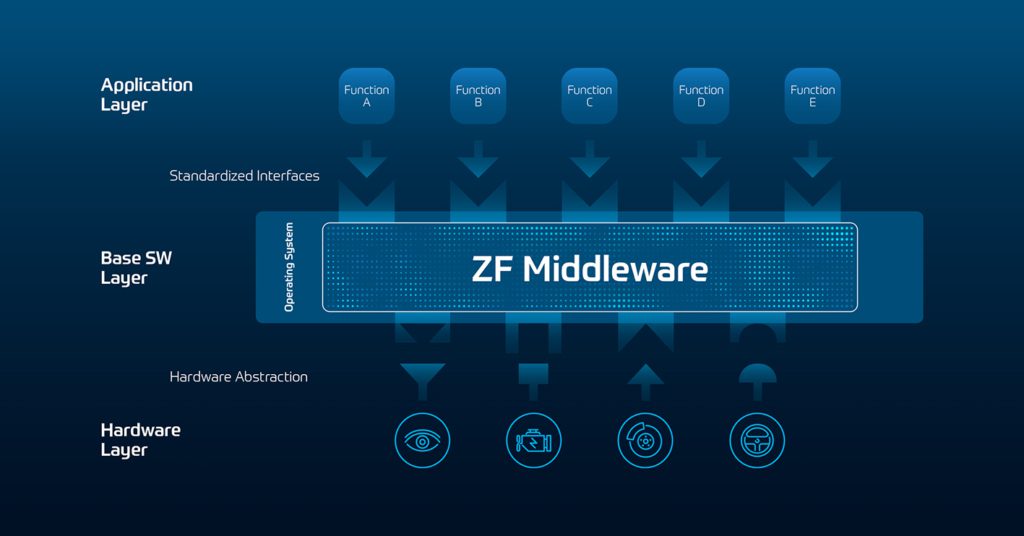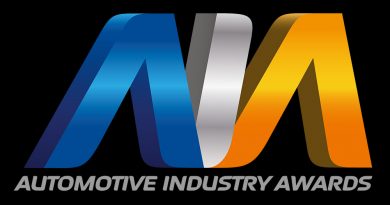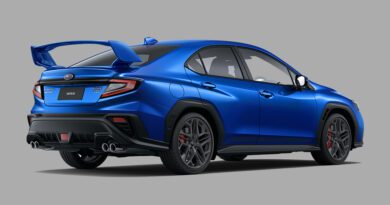ZF Establishes Global Software Centre
ZF says the vehicle of the future will feature high levels of networking and automation defined by software, but a “software-defined car” is much more than a ‘smartphone on wheels’ even if the vehicle operation increasingly resembles that of a smartphone. The difference is the quality and quantity of hardware systems that need to be intelligently connected by a software platform to help move people comfortably and safely.
In a preview to CES 2021, ZF presented its new middleware. This open software platform is a ‘mediator’ between a vehicle computer’s operating system and its software applications. Key functions of the middleware are the abstraction of computing hardware from software applications and the communication between these applications.
“The new ZF middleware underpins ZF’s claim to be one of the world’s leading system suppliers for the software-defined car of the future”, said Dr Dirk Walliser, Senior Vice President Research & Development, Innovation & Technology at ZF.
“Our customers benefit from accelerated development processes and significantly reduced complexity when integrating hardware and software. Throughout the vehicle’s lifetime, functions can be updated or additionally offered on-demand.”
As a comprehensive software platform, the ZF middleware will be available in series vehicles from 2024. Its development is closely connected to the development of application software for mobility domains like automated driving, integrated safety, vehicle motion control and electric mobility.
System Solutions for the Software-Defined Car
Bits and bytes have been allowing vehicle components to communicate with each other for almost five decades since the first electronic control units (ECUs) were installed in cars in the 1970s. Today, vehicles may have up to 100 different ECUs, each of them with their own software.
In new and future vehicle platforms, the electric and electronic architecture (E/E architecture) will change dramatically. Software functions will move away from decentralised controllers towards a centralised system with only a few dedicated domain control units (DCUs), such as those for automated driving functions. All these software applications benefit from a smoothly integrated middleware platform managing system integration.
Middleware reduces complexity for System Integration
Being a connector to the software applications and the hardware components of a vehicle, only the middleware needs to be connected to the operating system. This approach minimises the interfaces, guarantees fast communication with all parts of the system and can help to significantly reduce the complexity of system integration for the OEM.
The same principle applies for the development of hardware components. The middleware simplifies their flexible integration into vehicles providing communication in ‘one universal language’. It ‘translates’ and standardises the communication between the vehicles different hard- and software layers.

Accelerated and improved processes
The open hard- and software architecture enables an accelerated and improved development process between ZF, vehicle manufacturers and other partners – from the first step of development and during the entire lifetime of the vehicle. As a result, vehicle manufacturers and end customers benefit from innovative vehicle functions that are always state-of-the-art.
Depending on the OEM’s software architecture, ZF offers a modular approach with its middleware, from a full platform solution to single modules that can be integrated into the OEM’s software platform. Thanks to its own scalable ZF ProAI supercomputing platform for next generation vehicles, ZF is capable of providing comprehensive systems comprising software, computing and sensor hardware as well as connected actuators.
Global Software Centre to be established in 2021
ZF has prepared for these new challenges in the triad of software, functions and smart systems and is proactively pursuing numerous development processes by establishing a Global Software Centre that will be headed by Dr Nico Hartmann, Vice President, Software Solutions & Global Software Center.
“Our Global Software Centre will be responsible for developing software systems for future architectures on a group-wide level and making them available to the entire company”, said Walliser.
This will allow ZF to coordinate and standardise new trends, technologies, methods, procedures, tools, and functions to make the resulting software available to all ZF divisions on a common development platform.
“Our approach represents a fresh and different look at software: We do not aim to ‘centralise’ software development,” said Hartmann. The reason is simple: Where experienced teams have long been developing interlinked hardware and software at component level, we will not reduce competencies. Instead, we provide complementary support and run joint software integration projects to create ideal overall conditions. This allows the expert teams to focus on their work but still have access to the latest resources via the Global Software Center. On the other hand, pure software products – such as our middleware – can be created centrally in the Global Software Center and then made available to everyone for further use.”
In the medium term, this will lead to uniform structures and a uniform development environment throughout the ZF Group. Software will be developed or adapted much faster to meet the needs of future software-defined vehicles through integrated cooperation with customers and partners.
ZF says its simultaneous and interlinked hardware and software development processes provide innovative, integrated and industry-leading solutions. They are not only unparalleled at component level but can also be expanded to comprehensive and intelligent vehicle systems that create a unique user experience.




